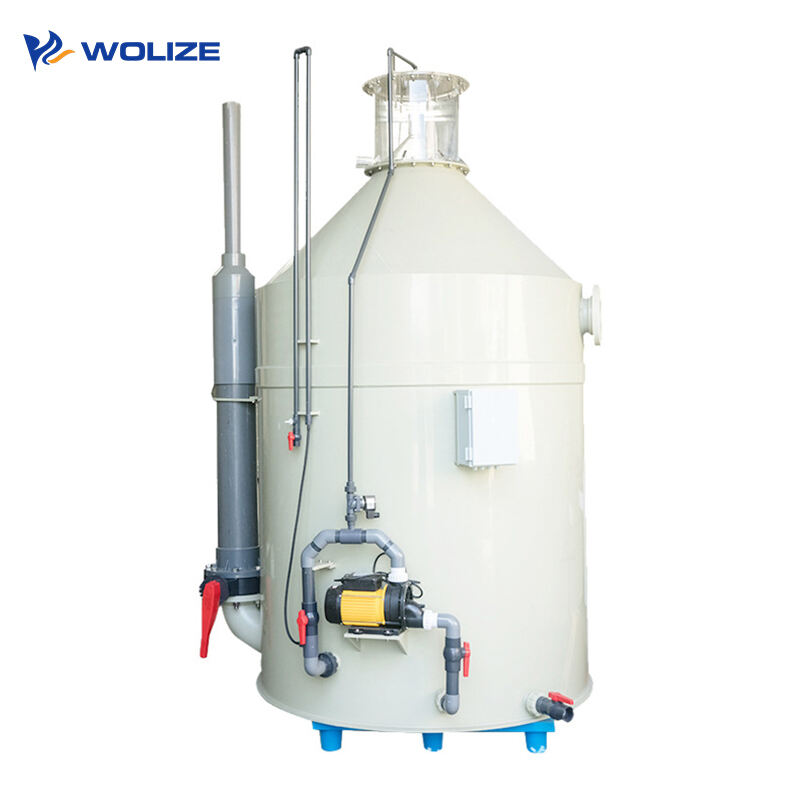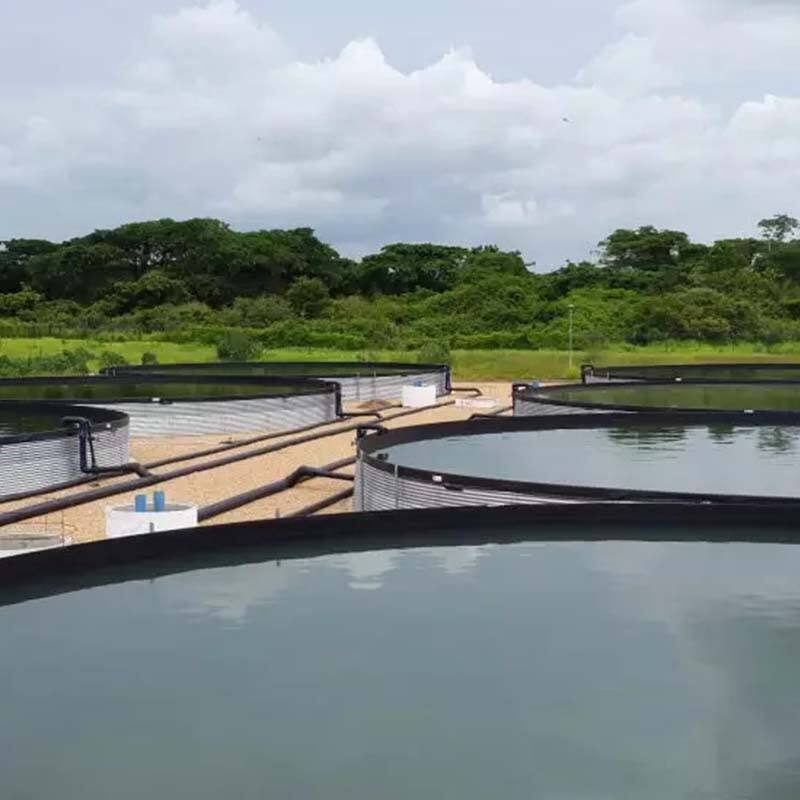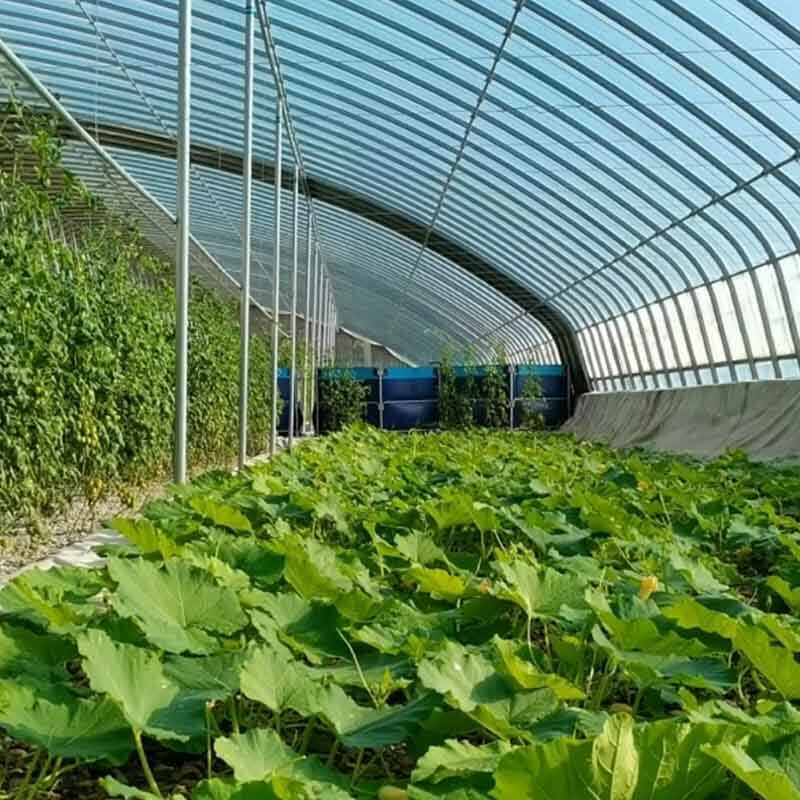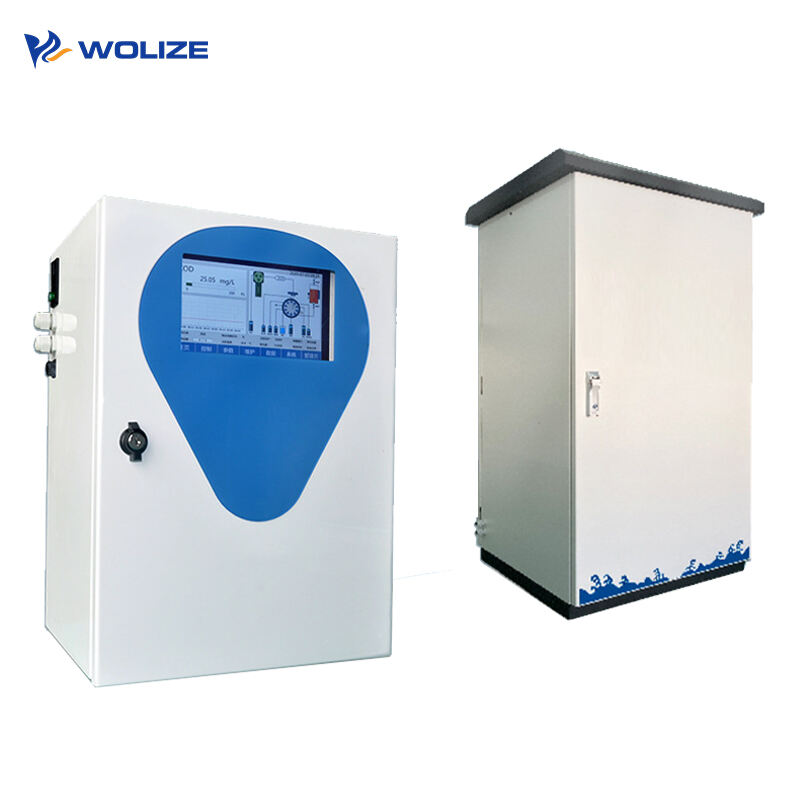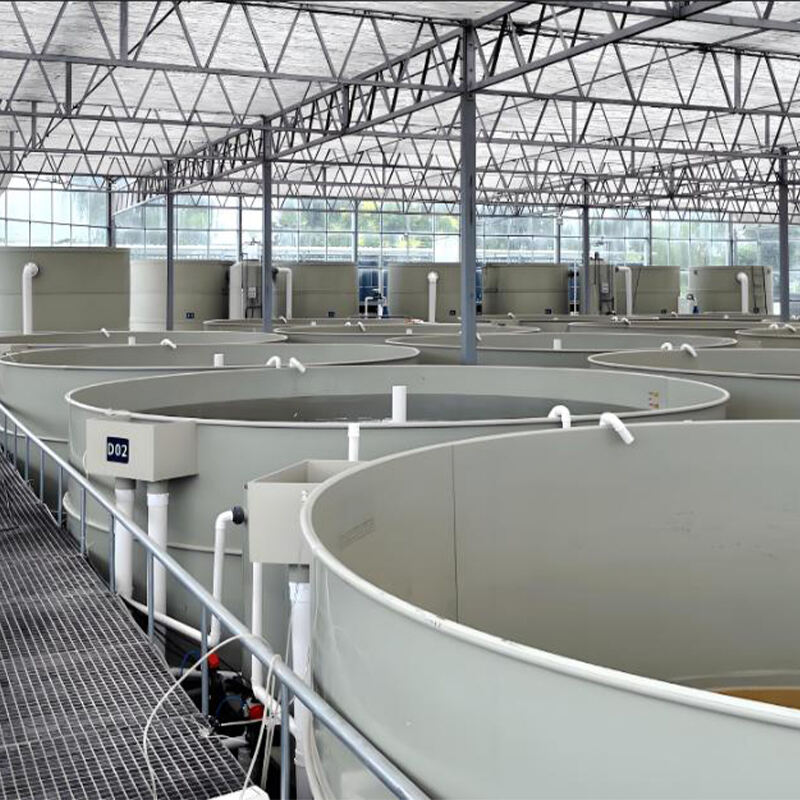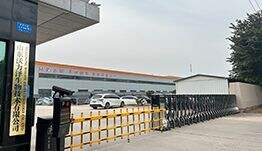Sistema de Aquicultura em Fluxo: Uma Nova Direção para a Piscicultura Eficiente
No setor da aquicultura, o sistema de aquicultura em fluxo está gradualmente surgindo e se tornando um método altamente aguardado. Com seu conceito e tecnologia únicos, trouxe nova vitalidade e oportunidades para o desenvolvimento da pesca.
1. O princípio e o encanto do sistema de aquicultura em fluxo
O sistema de aquicultura em fluxo, como o nome sugere, é a criação intensiva de peixes em alta densidade em um tanque de peixes com troca de fluxo de água. Seu princípio fundamental é utilizar de forma inteligente a força do fluxo de água para criar um excelente ambiente de vida para os peixes. Normalmente, reservatórios, lagos, rios, riachos de montanha, nascentes, entre outros, são utilizados como fontes de água. Com o auxílio de diferenças de nível da água, instalações de desvio ou barragem e bombas hidráulicas, permite-se que a água flua continuamente através do tanque de peixes, ou que a água descarregada seja purificada e reinjetada novamente no tanque. O fluxo de água desempenha um papel fundamental aqui. Ele não apenas fornece continuamente oxigênio dissolvido para atender às necessidades respiratórias dos peixes, mas também consegue remover prontamente os dejetos dos peixes, manter efetivamente a boa qualidade da água do tanque e estabelecer uma base sólida para a criação intensiva de peixes em alta densidade.
2. Vários tipos de sistema de aquicultura em fluxo
- Fluxo aberto ing aquaticultura sistema
- Fluxo em temperatura normal sistema de aquicultura em fluxo : Esta é a forma principal de fluxo ing aquaticultura sistema , que possui diversas vantagens significativas. Requer um investimento pequeno, o processo de construção do tanque é relativamente simples e a administração diária também é bastante conveniente. Utiliza completamente fontes naturais de água, e a temperatura da água não é ajustada artificialmente. Como a água descarregada não é reutilizada, sendo continuamente substituída por água nova, é possível manter sempre boas condições de qualidade da água. No passado, na aquicultura familiar nas áreas montanhosas do meu país, bem como em templos e parques destinados à criação de peixes ornamentais, frequentemente adotava-se este método. A partir dos anos 1970, diversas espécies de peixes, como peixes não carpados, carpas, capins, pratas, enguias e percas, sucessivamente tornaram-se objetos de cultivo dentro deste sistema, e o escopo da aquicultura também se expandiu da simples criação de peixes comestíveis para a reprodução de alevinos e espécies específicas. Em fluxo com temperatura normal ing aquaticultura sistema , existe um ponto fundamental, ou seja, em determinadas condições, a vazão e a produção são diretamente proporcionais. Portanto, aproveitar ao máximo a diferença de terreno ao construir o tanque, de modo que o tanque de peixes possa obter uma grande vazão, e o fluxo de entrada e saída de água no tanque de peixes não exija potência adicional, tornou-se um fator crucial para determinar se este método de cultivo possui valor de produção.
- Água morna: O destaque da piscicultura em águas quentes abertas é a capacidade de regular a temperatura da água. Esse método utiliza de forma inteligente fontes naturais de água com temperatura mais alta que a do ar, como nascentes termais, poços profundos ou águas aquecidas provenientes de empresas industriais e mineradoras (principalmente usinas termelétricas), como fonte principal ou complementar de água, injetando-a junto com água natural em temperatura ambiente no tanque de peixes. Controlando com precisão a vazão de ambas, é possível manter a temperatura adequada da água no tanque. Este método de criação apresenta vantagens evidentes. Não apenas permite aumentar a densidade de cultivo, como também acelera significativamente o crescimento e desenvolvimento dos peixes. Na estação fria, consegue manter a temperatura da água do tanque adequada ao crescimento dos peixes, estendendo efetivamente o período de crescimento e reduzindo o ciclo de criação. Ao mesmo tempo, pode promover ou inibir o desenvolvimento gonadal dos reprodutores. Em regiões de baixa temperatura, utilizar água aquecida para a criação de reprodutores pode antecipar o período reprodutivo, aumentando assim o tempo de alimentação das alevinos e criando condições favoráveis para o cultivo de espécies de peixe de maior porte.
Fluxo em circuito fechado ing aquaticultura sistema : Fluxo em circuito fechado ing aquaticultura sysytem também é conhecida como aquicultura com filtração em circuito fechado. Seu maior destaque é o fato de que o esgoto descarregado do tanque é purificado e depois injetado novamente no tanque de peixes, reduzindo significativamente o consumo total de água em comparação com as duas formas anteriores, além de permitir manter a temperatura da água constante mediante aquecimento. A tecnologia básica deste método de criação teve origem nos aquários. Já no final do século XIX, países como os Países Baixos, Estados Unidos e Reino Unido começaram a utilizar a filtração em circuito fechado para tratamento de água na criação de peixes, permitindo o reuso da água por décadas. Na década de 1960, devido à poluição das águas em muitos países e à crescente demanda por peixes vivos no mercado, esse método de criação foi gradualmente introduzido no campo de reprodução de alevinos e produção de peixes para consumo, desenvolvendo-se assim em um novo processo de criação. No tanque de filtração em circuito fechado, o esgoto descarregado contém substâncias nocivas, como fezes de peixes e amônia resultantes da decomposição da ração residual, o que pode prejudicar o crescimento dos peixes; por isso, deve ser filtrado e purificado antes de ser reutilizado. O processo geral de tratamento consiste em primeiramente arejar o esgoto descarregado, depois deixá-lo decantar e remover sólidos em suspensão, como fezes de peixe, restos de ração e detritos. Em seguida, utiliza-se um biofiltro ou um biodisco para purificação biológica. O biofiltro clarifica ainda mais a água ao reter parte das partículas em suspensão restantes na água nas lacunas do material filtrante (seixos, areia amarela, partículas plásticas, malhas etc.) ou depositá-las em sua superfície. Ao mesmo tempo, com a ajuda da comunidade microbiana (biofilme) que cresce na superfície do material filtrante, a amônia e o nitrito dissolvidos na água são oxidados em substâncias não tóxicas, completando assim o processo de purificação do esgoto. O biodisco utiliza a comunidade microbiana que cresce na superfície do disco (cilindro) para oxidar a matéria orgânica na água. A água purificada é então arejada e retorna ao tanque de peixes. Se for um sistema de filtração com circulação de água quente, também é necessário utilizar vapor ou caldeiras de água quente para aquecimento após a filtração. Durante todo o processo, a qualidade da água precisa ser rigorosamente monitorada e gerenciada de acordo com os padrões estabelecidos. Além disso, devido à alta densidade de peixes criados com este método, é necessário alimentá-los com ração granulada de nutrição completa, para evitar deficiências nutricionais nos peixes e perda de ração. Além disso, nos tanques de filtração em circuito fechado, a ocorrência e propagação de doenças nos peixes são extremamente rápidas, sendo necessário estabelecer um rigoroso sistema de prevenção de epidemias. Assim que forem detectadas doenças, os peixes doentes devem ser isolados e tratados rapidamente, e todo o sistema deve ser desinfetado. A área dos tanques fechados de circuito fechado geralmente é pequena, variando entre poucos metros quadrados a dezenas de metros quadrados, e a maioria é construída em ambientes internos. Todo o equipamento abrange várias partes, como o sistema de tanques (tanque de peixes e tubulações de entrada e saída), sistema de purificação (tanque de sedimentação, tanque de filtragem), sistema de abastecimento de água, sistema de fornecimento de ar, sistema de aquecimento, entre outros, sendo centralmente controlado e modernizado por meio do sistema de monitoramento e controle. Este método de gestão altamente integrado e inteligente permite um forte controle sobre o ambiente de criação de peixes e um grande potencial produtivo, sendo especialmente adequado para a reprodução de peixes de qualidade e espécies valiosas. Tem um valor de utilização extremamente alto em grandes cidades, áreas industriais e mineradoras ou regiões com escassos recursos hídricos. Porém, seu custo de construção é elevado, o nível técnico de gestão é alto e o consumo de energia também é elevado.
3. Vantagens significativas do sistema de aquicultura em fluxo
- Excelente qualidade da água: A água em fluxo contínuo traz constantemente oxigênio dissolvido suficiente para o tanque de peixes, ao mesmo tempo em que remove os dejetos dos peixes e a ração não consumida, evitando efetivamente a degradação da qualidade da água, reduzindo significativamente o risco de doenças nos peixes e proporcionando um ambiente limpo e saudável para seu crescimento. Por exemplo, em algumas fazendas de peixes que adotam a aquicultura em fluxo contínuo, a incidência de doenças nos peixes diminuiu [X]% em comparação com a aquicultura tradicional em tanques.
- Crescimento rápido: A boa qualidade da água e o oxigênio dissolvido suficiente permitem que os peixes cresçam em um ambiente mais adequado, acelerando o metabolismo e aumentando significativamente a taxa de crescimento. Tomando como exemplo a truta arco-íris, nas condições de aquicultura em fluxo contínuo, seu ciclo de crescimento é encurtado em [X] meses em comparação com os métodos convencionais de aquicultura, e a produtividade também é significativamente maior.
- Aquicultura de alta densidade: A aquicultura de fluxo contínuo cria condições para uma aquicultura de alta densidade, aumentando significativamente o volume de produção por unidade de área e melhorando efetivamente a eficiência na utilização da terra e dos recursos hídricos. Estatísticas indicam que, na mesma área de cultivo, a produção da aquicultura de fluxo contínuo pode ser aumentada em [X] vezes em comparação com a aquicultura tradicional em tanques.
- Gestão precisa: Com o auxílio de tecnologias modernas de monitoramento e controle, fatores-chave como fluxo de água, temperatura da água, oxigênio dissolvido e alimentação podem ser controlados com precisão, permitindo uma criação científica e aumentando a eficiência da produção. Por exemplo, sensores são utilizados para monitorar em tempo real os parâmetros da qualidade da água, enquanto o fluxo de água e os equipamentos de oxigenação são ajustados automaticamente, garantindo que os peixes estejam sempre em condições ideais de crescimento.
- Olhando para o futuro do sistema de aquicultura de fluxo contínuo
Com o contínuo avanço da ciência e tecnologia e o crescente demanda pela qualidade e quantidade de produtos aquáticos, a aquicultura de fluxo contínuo enfrentará um espaço ainda mais amplo para desenvolvimento. Por um lado, em termos de inovação tecnológica, os equipamentos e sistemas de gestão para a aquicultura serão ainda mais otimizados, visando elevar o nível de inteligência e automação dessa prática. Por exemplo, tecnologias de inteligência artificial serão utilizadas para possibilitar o monitoramento em tempo real e o controle preciso da qualidade da água e das condições de crescimento dos peixes, desenvolver tecnologias de tratamento de água e fórmulas de ração mais eficientes, reduzir os custos de cultivo e melhorar a rentabilidade. Por outro lado, no que diz respeito ao desenvolvimento sustentável, os sistemas de aquicultura de fluxo contínuo estarão mais focados na proteção ambiental, reduzindo o desperdício de recursos hídricos e a poluição ambiental por meio da otimização dos modelos de cultivo. Ao mesmo tempo, fortalecer-se-á a integração e desenvolvimento com outras indústrias, como o turismo e a agricultura de lazer, criando produtos e serviços pesqueiros mais diferenciados e aumentando o valor agregado da indústria. Além disso, com o aumento contínuo da demanda global por produtos aquáticos, os sistemas de aquicultura de fluxo contínuo devem desempenhar um papel ainda mais importante no mercado internacional, promovendo o desenvolvimento global da pesca.
Como um método de cultivo eficiente, ecológico e sustentável, a aquicultura em fluxo contínuo está liderando a indústria de aquicultura para uma nova fase de desenvolvimento, com suas vantagens e atratividade únicas. Ela não apenas traz maiores benefícios econômicos aos agricultores, mas também contribui positivamente para garantir a segurança alimentar e proteger o meio ambiente ecológico. Acredito que, no futuro, a aquicultura em fluxo contínuo continuará inovando e se desenvolvendo, trazendo mais surpresas e bem-estar às pessoas.
Produtos Recomendados
Notícias em Destaque
-
O desconto de Natal chegou
2024-12-26
-
É verdade que criar peixes em tanques de lona de alta densidade é mais eficiente do que em lagoas comuns?
2024-12-16
-
Vantagens da lagoa de peixes com tela galvanizada
2024-10-14
-
Tecnologia de criação de peixes de alta densidade, custo da lagoa de peixes, lagoa de peixes com tela, lagoa com tela, criação de peixes de alta densidade
2024-10-12
-
Por que escolher aquicultura de alta densidade com água corrente
2023-11-20












































